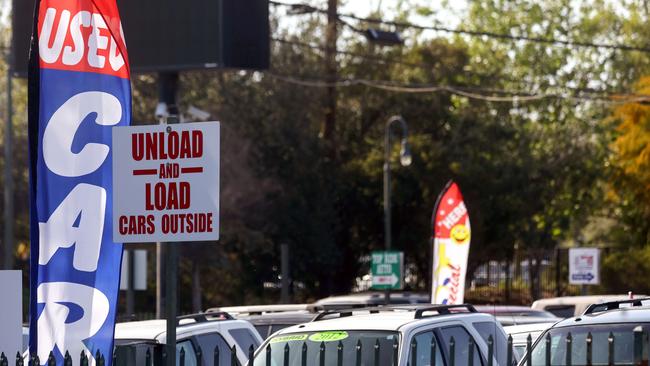As gas prices soar, buyers find fewer fuel-efficient car options
With SUV and truck sales booming in the US in recent years, many automakers scaled back on smaller options; electric-vehicles remain limited.

Americans looking to offset surging gasoline prices with a more fuel-thrifty vehicle aren’t likely to find much on the car lot today.
The sharp rise in fuel costs, driven in large part by the war in Ukraine and related disruptions, is delivering another shock to the car business and triggering renewed focus on fuel economy after a multiyear boom in sport-utility vehicle and pick-up truck sales. It also comes as new- and used-car inventory on dealership lots is at historic lows, leaving buyers with slim pickings for those looking to make a switch, according to dealers, executives and analysts.
Average gas prices in the US hit $US4.33 ($A5.94) Saturday after recently breaking a record set in July 2008, according to AAA. A US ban on Russian oil imports, revealed Tuesday, is poised to drive fuel costs higher in the near-term.
While still early, buyers are already showing more interest in gas-sipping models, including hybrids and electric vehicles, dealers and analysts say.
Bret Biornstad, a 62-year-old teacher living in Portland, Oregon, said rising gas prices have pushed him to consider replacing the Kia Rio sedan he bought just a year ago with a fully electric vehicle.
“With the gas prices and the invasion of Ukraine, it was kind of like, ‘I’m going to really seriously look into this,’” Mr Biornstad said.
Within the past decade, the car business has moved away from the small cars and sedans that have historically been the go-to for better fuel-economy and focused on bigger and more-lucrative trucks and SUVs during an era of low gasoline prices.
Buyers, too, have gravitated to larger, more fuel-thirsty models, leading many automakers to discontinue some of their most fuel-efficient offerings in the US — models such as the Ford Fiesta, Honda Fit and Toyota Yaris.
Nearly 78 per cent of all vehicles sold last year were SUVs and trucks, a stark reversal from a decade ago when those types of vehicles accounted for about 55 per cent of total US industry sales, according to data analytics firm Wards Intelligence.
Auto executives are bullish on boosting sales of EVs, but the selection on dealership lots is still limited.
Many models, including those sold by Tesla and Ford Motor, have long wait times that stretch out for several months and carry heftier price tags — selling for nearly $US15,000 more than the average price paid for all vehicles in February, according to data compiled by car-shopping firm Edmunds.com.
“Are the dealers ready? Yes. We are excited. We’re all in on EVs,” said Mike Stanton, president of the National Automobile Dealers Association, at a gathering of dealers in Las Vegas over the weekend. “We just don’t have the product right now.” Further adding to the challenges for buyers is a nearly year-long shortage of both new and used vehicles that has pushed up prices and left new-car lots stripped of stock.
The inventory crunch is particularly acute on passenger cars, such as compacts, sedans and even some hybrids, industry data shows. That is because supply-chain constraints led many car companies to pull back on building these cars to focus on higher profit trucks and SUVs, analysts and executives say.
At the end of February, there were a little more than 1 million vehicles in transit or in stock at US dealerships, compared with 2.7 million in the same month last year, according to Wards Intelligence. And most vehicles are already pre-sold, meaning shoppers walking into showrooms won’t find many options on the ground, dealers and auto executives say.
Typically a $US2-a-gallon jump in gasoline price is enough to alter consumer behaviour, but in today’s market, it is tough to quantify that change, said Jay Joseph, vice president of marketing and consumer experience at American Honda Motor.
“We’re not seeing a true open market,” Mr Joseph said. “If we had cars on the ground, I think we would see a temporary shift to passenger cars right now. But there is no supply of anything.” The auto industry has long scrambled to adjust to sudden increases in the cost of fuel. In 2008, when gasoline prices topped $US4 a gallon, the rush among buyers to snatch up small cars was so sudden that some used models were fetching prices close to new ones.
During the financial crisis, the Detroit automakers — stung by higher fuel costs — vowed to better balance out their truck and SUV-heavy line-ups with more fuel-efficient offerings, adding more small cars and sedans, and even rolling out new electrified options. But the move was short-lived. Once fuel costs fell again, buyers swung back in the other direction, and many of those models were killed off.
Still, the auto industry has vastly improved the gas mileage of today’s SUVs and trucks, using lighter materials, smaller engines and offering downsized versions of the bigger, popular body styles.
In 2020, crossover SUVs on average achieved a real-world fuel economy of 28.4mpg, compared with 23mpg a decade earlier, according to Environmental Protection Agency data. Sedans and wagons, comparatively, are still more efficient, averaging 31.7mpg in real-world driving, the EPA found.
“Even if you do get something that is a little bit larger, it is more fuel efficient than it was back then,” said Jessica Caldwell, an auto analyst at Edmunds.
Some car companies, such as Honda, Toyota Motor and Hyundai Motor, are better positioned to accommodate buyers looking for better fuel economy, mostly because they have stuck to their small-car and sedan offerings. The challenge is they don’t have many in stock, she added.
Dealers say for now, it is too soon to tell how big an impact gasoline prices will have on buyers’ behaviour, especially because for most car shoppers the lack of vehicle availability remains top of mind.
JP Miller, chief executive officer of Paul Miller Ford in Kentucky, said the car business has weathered previous gasoline spikes in the past, which makes this increase feel less daunting. If anything, the higher fuel costs are helping to build awareness around EVs as car companies and regulators are trying to push greener options.
“I think the pent-up demand is there, and this awareness is allowing them to see that new vehicle,” Mr Miller said.
The Wall Street Journal


